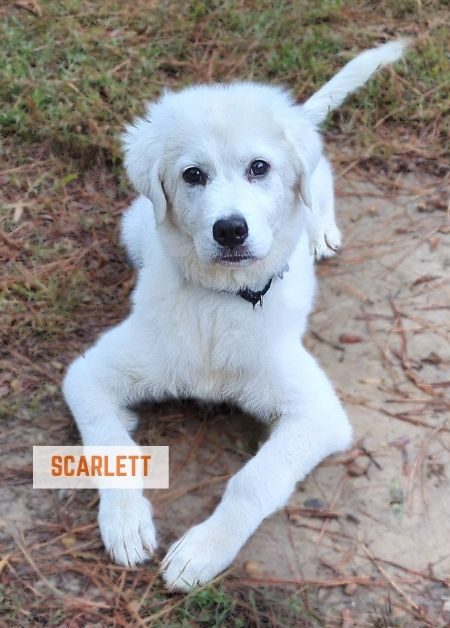
Commonly Uncommon: Breed-Specific Health Issues Great Pyrenees Face
When you think of a Great Pyrenees, you might picture a majestic, fluffy giant gently napping at your feet or standing sentinel in your yard, silently watching over the family. Known for their calm, devoted nature, these gentle giants bring love, loyalty, and quiet strength to every home. But like all breeds, Great Pyrenees have their own health considerations that their human counterparts should understand.
 Take Scarlett, a rescue Pyr at AGPR who struggles with hip stiffness, even at a young age. Originally a stray, Scarlett was returned by a family that wouldn’t be able to care for her once full grown. Still shy of 6 months, Scarlett is growing, enjoying scrambled eggs and leading a wiggly, sweet life, occasionally ‘bunny-hopping’ her back legs to compensate for her hips.
Take Scarlett, a rescue Pyr at AGPR who struggles with hip stiffness, even at a young age. Originally a stray, Scarlett was returned by a family that wouldn’t be able to care for her once full grown. Still shy of 6 months, Scarlett is growing, enjoying scrambled eggs and leading a wiggly, sweet life, occasionally ‘bunny-hopping’ her back legs to compensate for her hips.
Scarlett’s story illustrates both the joys and challenges of caring for these incredible dogs. While her heart is full of love and loyalty, managing her mobility and comfort requires knowledge and patience.
Vet Insights on Temperament and Care
According to the VCA Animal Hospital, Great Pyrenees are “devoted to their family – especially to children,” yet they also value their personal space. Their calm, sedate demeanor and natural protective instincts are inherited from centuries of guarding livestock in mountainous regions. This independence and strong will can make training a challenge but also highlights their thoughtful, watchful nature.
Dr. Teresa Kho‑Pelfrey, DVM (PetMD) echoes this perspective, noting that Great Pyrenees are generally gentle and calm at home and do not require a highly active lifestyle. Owners should expect a loyal companion who enjoys quiet moments as much as playtime, but who may also insist on a bit of independence.
Health Issues to Watch For
While Great Pyrenees are generally healthy for a giant breed, they are prone to several breed-specific conditions:
- Hip and elbow dysplasia: Painful joint disorders that can affect mobility, like Scarlett experiences. This can also lead to patellar luxation, where the kneecap shifts to either side of the leg. In large breeds like Great Pyrenees, lateral luxation (kneecap slipping outward) is more typical and often linked to hip dysplasia or poor bone alignment.
- Because Pyrs carry a lot of weight, repeated luxation can cause arthritis, joint inflammation, and mobility loss over time.
- Gastric torsion (bloat/GDV): A life-threatening, rapid-onset emergency requiring immediate veterinary attention.
- Eye issues: Conditions such as entropion, cataracts, or multifocal retinopathy can affect vision.
Vets and breed clubs, including the Great Pyrenees Club of America, emphasize that awareness and early intervention are key to keeping these gentle giants healthy and comfortable. They recommend keeping an eye on weight gain and exercise habits, as these can contribute to joint issues.
Caring for a Great Pyrenees
For owners, fosters, and Pyr/big-breed lovers of all kinds, the takeaway is clear: Great Pyrenees are loyal, loving companions, but their size and breed-specific tendencies require thoughtful care. This includes:
- Regular veterinary check-ups, particularly for hips, elbows, and eyes.
- Patience with training and respect for their independent streak.
- Comfort measures for mobility challenges, like orthopedic beds or ramps.
- Exercise management
Scarlett’s journey reminds us that even dogs with health challenges can thrive in loving homes, given knowledge, compassion, and support. With proper care, Great Pyrenees live full, joyful lives, and bring immeasurable love to the families who welcome them.
Article written by author Kasey Fallon. Learn more at her website.
